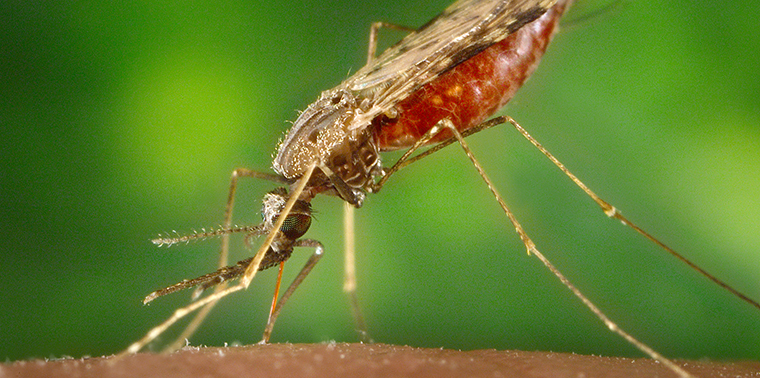October 27, 2014 — By the quirks of genetics, some people are natural mosquito bait. In any group of 10, it seems, one person will draw a fury of bites, while the rest get off lightly. Which makes a dreamer wonder: Why not devise a nonhuman target to attract mosquitoes and so reduce the toll of mosquito-borne diseases without having to eliminate mosquitoes? Traps have had some success at this, but psychologists Marc Egeth and Robert Kurzban suggest we go one step further: Design an artificial feeder that offers a more attractive meal than the most enticing of humans, and then let evolution augment its effectiveness.
The pair published their proposal in the journal Evolutionary Psychology in 2012. Their field usually deals with adaptive pressures on the human mind — but they had started talking about adaptive pressures on mosquitoes, and ended up brainstorming how we might direct those pressures to reduce the toll of mosquito-borne diseases.
According to a 2013 World Health Organization report, malaria alone threatens almost half the world’s population and killed some 600,000 people — most of them children — in 2012.
On a global scale, such diseases are devastating. According to a 2013 World Health Organization report, malaria alone threatens almost half the world’s population and killed some 600,000 people — most of them children — in 2012. Currently, insecticides form the backbone of global control. But these chemicals are often persistent pollutants. And, from an evolutionary perspective, they are counterproductive. We deploy insecticides; mosquitoes evolve resistance. Over a decade ago, for example, South Africa was forced to switch back to DDT after substitute insecticides lost their effectiveness.
“What if we let evolution work for us instead of against us?” Kurzban asks. “Is there a way we can use the power of selection to roll downhill, instead of pushing uphill?”
In their proposal, Egeth and Kurzban imagine a vessel stocked with blood and equipped with a membrane that simulates skin: a feeder that smells attractively human and exhales puffs of carbon dioxide. From a mosquito’s perspective, it would be as good as a person. Better, in fact: Any mosquito attracted to this feeder could avoid human defenses — slapping, insecticides, bed nets. A mosquito feeding from the feeder should be more likely to survive, and more likely to lay eggs. Over time, natural selection would favor the mosquitoes that favor the feeders.
The proposal remains untested, but proofs of principle abound.By working with rather than against evolution, the approach would circumvent the evolutionary arms race between mosquitoes and insecticides. What’s more, a feeder, in contrast to current “kill ’em all” strategies, wouldn’t disrupt local ecosystems. Mosquitoes could continue providing food for swallows and dragonflies, pollinating flowering plants, and processing organic debris in their larval stage. Each time the feeder diverts a malaria-laden mosquito from a person, we could tally up one small, significant victory against human disease — and one in favor of the health of the ecosystems of which mosquitoes are a part.
The proposal remains untested, but proofs of principle abound. Scientists have used membrane feeders in labs to raise mosquito colonies for decades. Wild mosquitoes get along fine on the blood of cattle and dogs, or even blood substitutes made of ingredients such as egg white and soy. For lures, feeders could borrow from mosquito traps, which now use synthetic odorants that are as attractive as a person. Even the use of selection to change mosquitoes’ diet has precedent. In 1964, entomologist Mick Gillies gave mosquitoes that preferentially fed on humans a choice: humans or cattle. The choice had a catch. He only bred the mosquitoes that fed on cattle. In less than six months, he shifted their natural preference away from humans. One might worry that the feeders would create a mosquito population boom, but Egeth and Kurzban suspect otherwise, pointing to research on tropical mosquito populations, which surge in the wet season and plummet in dry months despite a steady abundance of hosts.
A mosquito feeder would still have to overcome a “whole cascade” of factors before it could be used in mosquito control.
The proposal has met with some skepticism. Tovi Lehmann, an entomologist with the National Institutes of Health, says a mosquito feeder would still have to overcome a “whole cascade” of factors before it could be used in mosquito control. It would need a design robust enough for use in the field; we would need to tune the feeder’s range of attraction and placement; the blood would need to be maintained at serving temperature. Robert Wirtz, chief of the Centers for Disease Control and Prevention’s entomology branch, says that a feeder would be so expensive, and would have to be so sophisticated, that the idea isn’t realistic. “If we eventually have a practical proposal,” says José Antonio Nájera, former director of the Division of Control of Tropical Diseases at the World Health Organization, the best we could expect might be “some success in specific situations, but rather inconsistent results elsewhere.”
Lehmann, though, is excited by the proposal’s potential to generate novel and insightful research. To the best of his knowledge, he says, short-term evolutionary change has not yet been exploited for such a task.
“If we don’t take moderate risks such as presented here (for great potential rewards),” he noted in an email, “we are wasting our opportunities.”
Egeth and Kurzban admit that obstacles exist. Still, they figure, it’s worth a try. “We and the mosquitoes would all prefer for them to eat something else,” they concluded in their paper. “Let’s give them something else to eat.” ![]()
Editor’s note: John McNair produced this article as a participant in the Ensia Mentor Program. His mentor for the project was Scientific American blogs editor and Columbia University adjunct faculty member Curtis Brainard.
Ensia shares solutions-focused stories free of charge through our online magazine and partner media. That means audiences around the world have ready access to stories that can — and do — help them shape a better future. If you value our work, please show your support today.
Yes, I'll support Ensia!

Like the people from CDC/WHO/NIH suggest, there are technical obstacles in the next step, which is constructing practical field-based mosquito feeders to try out.
However, it does not strike me as impossible. Rather, more like ... an interesting thing to tackle.
Some ingenuity might be called for.
Maybe advertising on the devices could bring down the cost. The feeders would be placed all over the developing world.
Let's crowdsource the design. Here is a google sheet for posting ideas.
http://goo.gl/5LUQY9
Marc Egeth, Ph.D.
Director of Research
Core Human Factors, Inc.
corehf.com